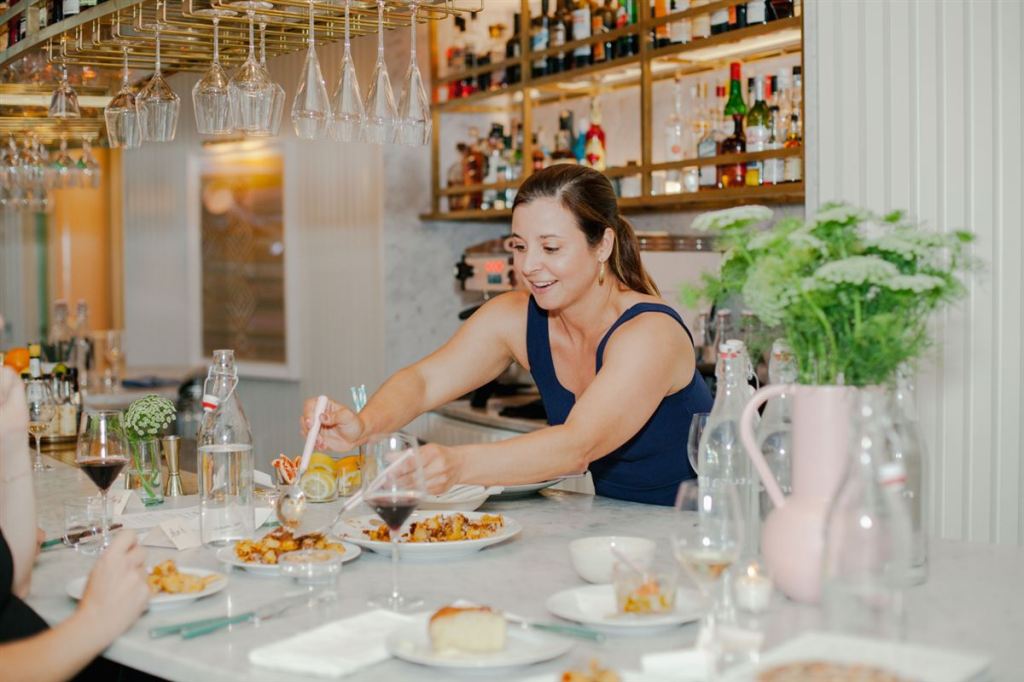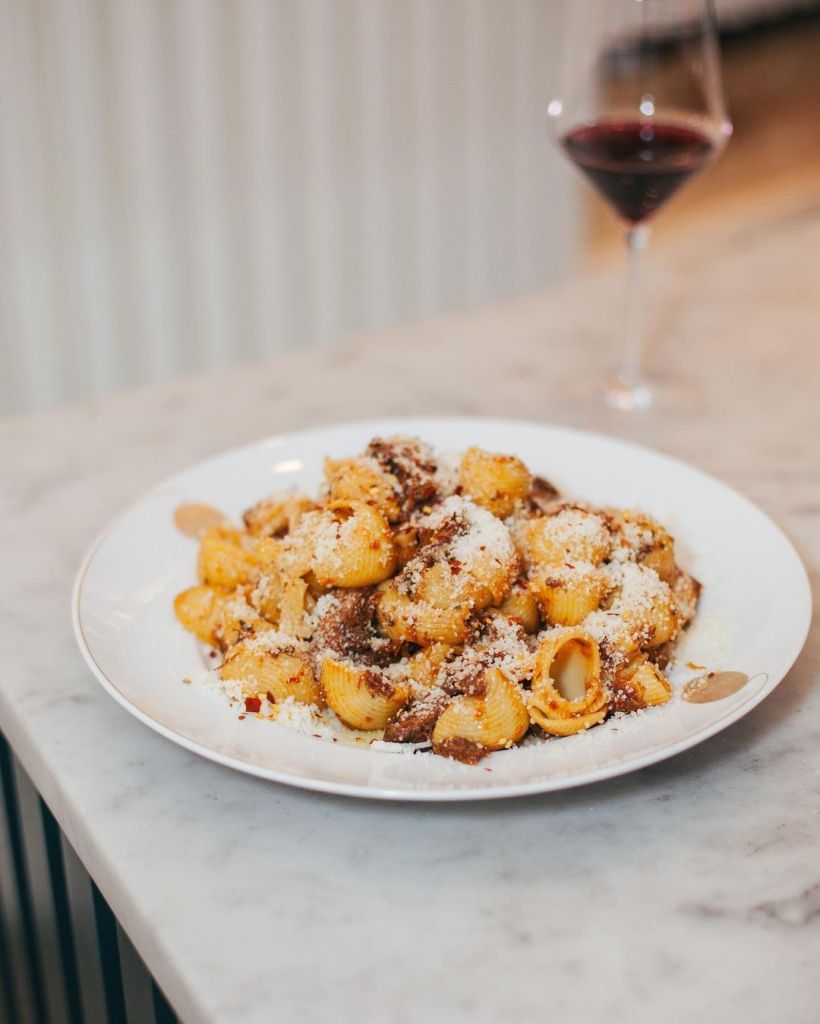Rome-based journalist Katie Parla is a food writer and cookbook author. She wrote about the sumptuous Roman dining scenes and expounded on its ancient food culture in publications such as Conde Nast Traveler, Bon Appètit and The New York Times. Her book Tasting Rome reads like a treasure trove of old world Italian recipes, straight from the tables of Rome’s renowned kitchens. Katie reveals where to go for an aperitif, the restaurants to avoid and the unlikely Roman classics to order.
Photo: Reva Keller
What do you feel defines Roman cuisine?
Roman cuisine can be defined in a number of ways. We can think of it as the natural evolution of cuisine passed down from the Popes, peasants, and shepherds of the past with the important addition that a lot of what we eat in Rome is influenced by the food of the Jewish community, which was confined to a Ghetto by the Pope for centuries. We can characterise it by its main ingredients and techniques: Pecorino Romano, lamb, pasta, tomato-based sauces, offal, and seasonal produce; frying, braising, roasting.
What is the one local dish you feel travellers can’t leave Rome without trying?
I’ll give one vegan dish and one that is the opposite of that. Cicoria ripassata in padella, a classic side dish of blanched, ideally wild, bitter greens that have been sauteed with extra-virgin olive oil, garlic, and peperoncino is a must try because it is nearly impossible to recreate elsewhere. I have tried. Roman cicoria is special. The other is rigatoni alla pajata. Everyone associates cacio e pepe and carbonara with the city. They are great. But ordering them is a no-brainer. Rigatoni con la pajata, pasta with the intestines of milk fed veal cooked in tomato sauce, is so profoundly and soulfully Roman. You would be hard pressed to find it anywhere else and it speaks to the Roman affection for offal, which I share.
What about your favourite restaurants?
I have so many! In the trattoria category I love Cesare al Casaletto, Santo Palato, Armando al Pantheon. All do classics with a few of their own spins on things. For coffee and pastries, I love Regoli. For coffee, I go to Sciascia for a classic experience and Faro for third wave.
Photo: Reva Keller
Where would you go for an aperitif?
I have a ton of go-to spots if I’m grabbing wine for aperitivo – Mosto’ in Flaminio, Litro in Monteverde Vecchio, Il Goccetto in Centro, La Mescita in Garbatella, Sorso in San Paolo, Il Vigneto in Pigneto. For cocktails, Mezzo in Pigneto or Fischio in Trionfale. I love Ma Che Siete Venuti a Fa’ and Artisan for beer.
Photo: Reva Keller
You talked about the quinto quarto on Stanley Tucci’s Searching for Italy. It was born out of poverty, but it seems like a no-waste approach when it comes to Italian cooking. Do you think it is more relevant today in light of the emphasis on environmental sustainability?
In reality, the quinto quarto (offal and poor cuts) isn’t just born out of poverty. If you look at Bartolomeo Scappi’s work, he documents plenty of offal cuts for Papal consumption. Organ meats taste good so the Roman nobility wanted to eat them, too. Certainly some of the quinto quarto classics derive from a culture of poverty, but not exclusively. Absolutely a no waste approach is typical of Italian regional cuisines, but it was typical of every cuisine I know of before the mid 20th century when the world began producing way more food than its population could reasonably consume.
The sustainability question is an interesting one. In Rome, there is more food waste than ever and while offal cuts remain a feature of the cuisine today, they aren’t as popular as they once were and the hunger for prime beef cuts is out of control. The number of Italian owned steakhouses and burger joints in town has absolutely exploded.
As you were originally from New Jersey, what’s the difference between coffee in America and coffee in Italy?
In Italy, coffee is pretty much exclusively related to two production methods – espresso machines and moka pots, both inventions of the early 20th century. Espresso is consumed on its own or with milk (cappuccino being the most popular example of this), quickly as the name suggests. Moka, which is not espresso by definition due to the lack of pressure in the pot, is consumed at home also on its own or with milk. Neither tradition calls for large quantities of lingering over a cup, whereas in New Jersey we have a little bit of everything, from gas station coffee to Starbucks to more thoughtful third wave coffee shops. I suppose we can also add the Swiss-born Nespresso machine to both Italian and New Jersian coffee practices!
Name some tourist traps travellers should avoid in Rome
Any place with a table out front overflowing with pasta dishes, pizza, pre-made cocktails and withering produce! All the places in Piazza del Colosseo. There are many others, of course, mainly situated near tourist attractions, but there are exceptions and you can eat really well at Armando al Pantheon even though it’s 150 feet from the Pantheon.
Name one best kept secret of Rome
If you have €100 cash and “know a guy”, you can visit the Jewish Catacombs off the Appia Antica. There’s no lighting system so you go in with flashlights and walk through these underground burial chambers and it’s amazing.
Where would you go in Rome if you’re longing for the countryside?
The Caffarella Park. It’s incredible. There are grazing sheep, ancient ruins, rolling hills and it feels totally rural even though it is trimmed by a densely populated residential neighbourhood.
WHERE TO EAT IN ROME
Trattoria Da Cesare al Casaletto
Where: Via del Casaletto, 45, 00151 Roma RM, Italy
For: Roman classics
Santo Palato
Where: Piazza Tarquinia, 4 a/b, 00183 Roma RM, Italy
For: Carbonara and daily specials
Armando al Pantheon
Where: Salita de’ Crescenzi, 31, 00186 Roma RM, Italy
For: Offal specialties
Pasticceria Regoli
Where: Via dello Statuto, 60, 00185 Roma RM, Italy
For: Coffee and pastries
Sciascia Caffè 1919
Where: Via Fabio Massimo, n.80/a, 00192 Roma RM, Italy
For: Coffee
Faro
Where: Via Piave, 55, 00187 Roma RM, Italy
For: Third wave coffee
Enoteca Mosto’
Where: Viale Pinturicchio, 32, 00196 Roma RM, Italy
For: Aperitivo
Litro
Where: Via Fratelli Bonnet, 5, 00152 Roma RM, Italy
For: An extensive wine list
Il Goccetto
Where: Via dei Banchi Vecchi, 14, 00186 Roma RM, Italy
For: Small bites
La Mescita
Where: Via Luigi Fincati, 44, 00154 Roma RM, Italy
For: Italian wine bar
Sorso
Where: Via Ostiense, 187, 00154 Roma RM, Italy
For: Aperitivo
Il Vigneto
Where: Piazza dei Condottieri 26/27 00176 Rome, Lazio, Italy
For: Aperitivo
Mezzo
Where: Via del Pigneto, 19, 00176 Rome
For: Cocktails
Fischio
Where: Piazzale degli Eroi, 00136 Roma RM, Italy
For: Cocktails
Ma Che Siete Venuti a Fa’
Where: Via Benedetta, 25, 00153 Roma RM, Italy
For: Beer
Artisan
Where: Via degli Aurunci, 7/9, 00185 Roma RM, Italy
For: Beer
WHERE TO GO IN ROME




